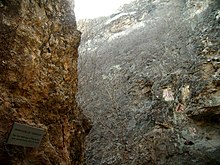Paleoanthropology
Paleoanthropology or paleo-anthropology is a branch of paleontology and anthropology which seeks to understand the early development of anatomically modern humans, a process known as hominization, through the reconstruction of evolutionary kinship lines within the family Hominidae, working from biological evidence (such as petrified skeletal remains, bone fragments, footprints) and cultural evidence (such as stone tools, artifacts, and settlement localities).As technologies and methods advance, genetics plays an ever-increasing role, in particular to examine and compare DNA structure as a vital tool of research of the evolutionary kinship lines of related species and genera.The modern field of paleoanthropology began in the 19th century with the discovery of "Neanderthal man" (the eponymous skeleton was found in 1856, but there had been finds elsewhere since 1830), and with evidence of so-called cave men.Even many of Darwin's original supporters (such as Alfred Russel Wallace and Charles Lyell) balked at the idea that human beings could have evolved their apparently boundless mental capacities and moral sensibilities through natural selection.Eleven years later, the Swedish geologist Johan Gunnar Andersson was sent to China as a mining advisor and soon developed an interest in "dragon bones".Zdansky conducted short-term excavations at Locality 1 in 1921 and 1923, and recovered only two teeth of significance (one premolar and one molar) that he subsequently described, cautiously, as "?Homo sp."News of the fossil hominin teeth delighted the scientific community in Beijing, and plans for developing a larger, more systematic project at Zhoukoudian were soon formulated.In late 1926, Black submitted a proposal to the Rockefeller Foundation seeking financial support for systematic excavation at Zhoukoudian and the establishment of an institute for the study of human biology in China.The first of the major project finds are attributed to the young Swedish paleontologist, Anders Birger Bohlin, then serving as the field advisor at Zhoukoudian.He recovered a left lower molar that Black (1927) identified as unmistakably human (it compared favorably to the previous find made by Zdansky), and subsequently coined it Sinanthropus pekinensis.Evidence of fire, marked by ash lenses and burned bones and stones, were apparently also present,[9] although recent studies have challenged this view.Although China re-opened its doors to the West in the late 1970s, national policy calling for self-reliance, coupled with a widened language barrier, thwarted all the possibilities of renewed scientific relationships.For example, in 2001, Zeresenay Alemseged discovered an Australopithecus afarensis child fossil, called Selam, from the site of Dikika in the Afar region of Ethiopia.In 2008, a team led by Lee Berger announced a new species, Australopithecus sediba, based on fossils they had discovered in Malapa cave in South Africa.[12] In 2015, a team also led by Lee Berger announced another species, Homo naledi, based on fossils representing 15 individuals from the Rising Star Cave system in South Africa.



AnthropologyOutlineHistoryArchaeologicalBiologicalCulturalLinguisticSocialAerialAviationBattlefieldBiblicalBioarchaeologicalEnvironmentalEthnoarchaeologicalExperimentalFeministForensicMaritimePaleoethnobotanicalZooarchaeologicalAnthrozoologicalBioculturalEvolutionaryMolecular NeurologicalNutritionalPrimatologicalAppliedCognitiveCyborgDevelopmentDigitalEcologicalEconomicPolitical economyHistoricalInstitutionalKinshipMedicalMuseumsMusicalPoliticalPsychologicalPublicReligionSymbolicTranspersonalVisualAnthropologicalDescriptiveEthnologicalEthnopoeticalIdeologySemioticSociologicalAnthropometryEthnographyEthnologyCross-cultural comparisonParticipant observationHolismReflexivityThick descriptionCultural relativismEthnocentrismEmic and eticCultureEthnicityEvolutionsocioculturalGenderKinship and descentPrehistorySocietyColonialismPostcolonialismActor–network theoryAlliance theoryCross-cultural studiesCultural materialismCulture theoryDiffusionismFeminismHistorical particularismBoasian anthropologyFunctionalismInterpretivePerformance studiesPractice theoryStructuralismPost-structuralismSystems theoryAnthropology by yearBibliographyJournalsList of indigenous peoplespaleontologyanatomically modern humansHominidaepetrifiedbone fragmentsstone toolsprimatologybiological anthropologycultural anthropologygeneticsgreat apehominoidHomininaeAfrican apechimpanzeesgorillasHomo sapiensSuborderHominoidsFamilyHominidsGorilliniHomininiArdipithecusAustralopithecusParanthropusKenyanthropusCarl LinnaeusSystema Naturae
